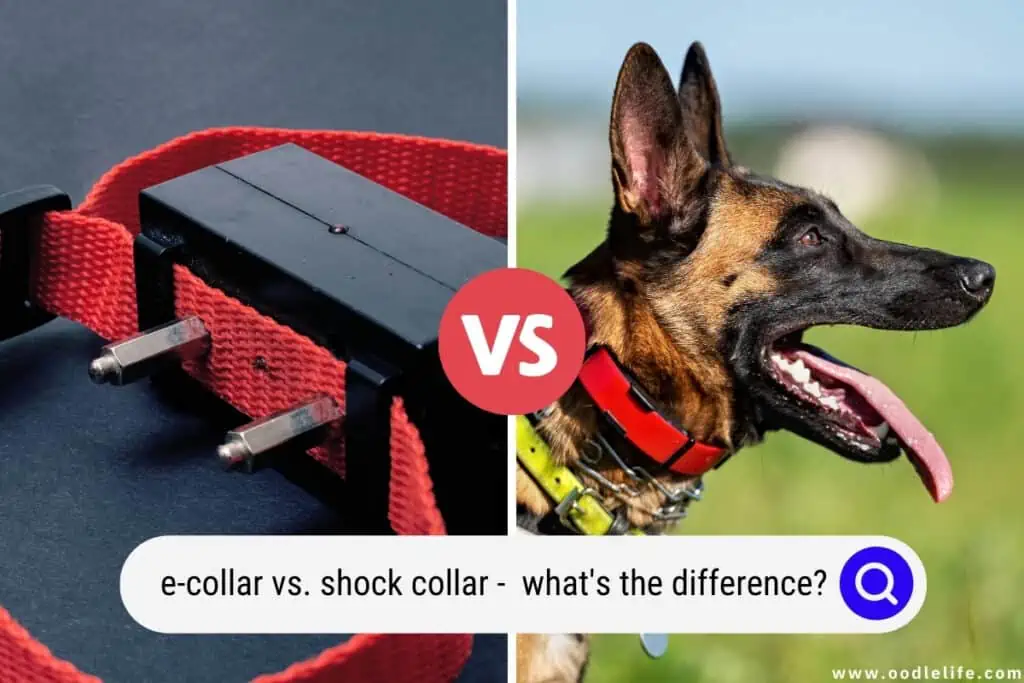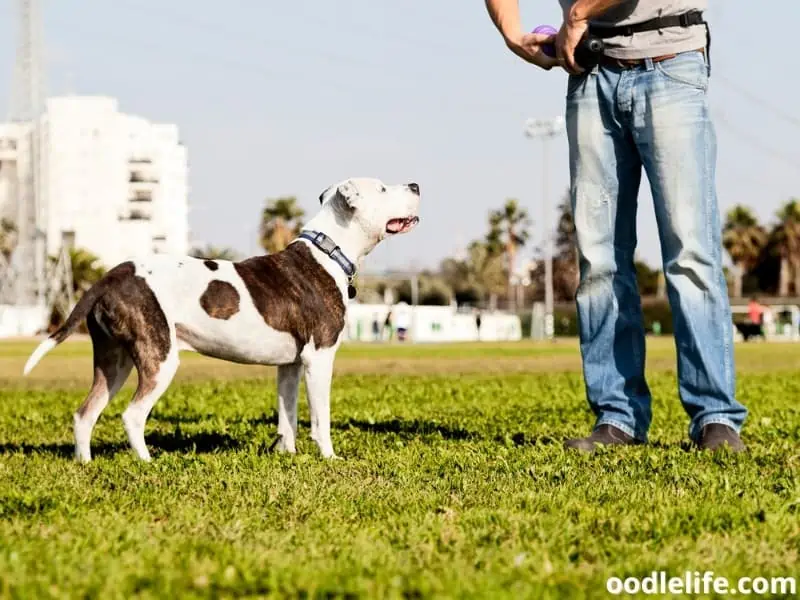E-Collar vs Shock Collar: What’s the Difference?
E-collars and shock collars are devices for correcting bad behavior in dogs. Some people refer to the former as the latter, while others believe that both tools are different.
The e-collar vs. shock collar debate will rage until the end, but this article will rest that argument. Do you want to know the truth?

Continue reading to find out!
E-Collar vs. Shock Collar: Here’s the Difference
Suppose you’re still deciding about testing out an e-collar for your furry friend. In that case, you might wonder if e-collars and shock collars are different and which will hurt your dog less. I’d hate to burst your bubble early on, but both devices are the same.

An e-collar is a shock collar and vice versa. However, e-collar sounds a little more humane, especially in an era with so much awareness of pet cruelty.
While technology continues to advance these devices to correct bad behavior without causing pain to the dog, it was originally known as a shock collar back in the day.
When you’re preparing to train your furry family member with an e-collar there are a few things you should know to prevent your dog from creating negative associations with the device.
E-Collar vs. Shock Collar: What You Should Know?
Shock collars became popular in the 70s as an instrument of control, delivering small jolts of electricity into the dog to adjust behavior. However, public outcry about its inhumane effects on dogs led to further development of the technology, and the e-collar was born.

Today’s collars cause no pain to animals when used on the right setting. The electric vibrations target the dog’s sensory receptors, breaking away its attention to focus on you. Still, the vibration causes discomfort, encouraging the dog to stop the action.
Remember that electronic stimulation isn’t an electric shock. You’re not harming your dog in any way.
How Do E-Collars Work?
E-collars use a radio signal to deliver a command to the transmitter your dog is wearing. This signal prompts vibrations that feel like a static shock. It doesn’t harm, but the sensation can startle.

The stimulation helps the dog to learn and remember simple commands like come, sit, heel, or stay. The stimulus also improves behavioral issues like destructive chewing, digging, chasing, and unnecessary barking.
Using an unpleasant sensation to adjust dog behavior is often seen as a negative form of correction, making many dog owners and trainers wary of the e-collar. However, today’s devices have gentler modes to cause even less discomfort.
The Benefits of an E-Collar
Many think using an e-collar is a rigid and primitive approach to training a dog, but it’s mostly about safety. For instance, you’re walking your dog when it sees a deer and quickly takes off.

The highway could be a short distance away, or someone else is out with a more aggressive dog nearby. Suddenly, you realize the importance of a device that gets your dog to obey commands 100 percent of the time.
An e-collar is leaps and bounds better than a choke, leash, or pinch collar, which causes great discomfort and pain to the dog. Still, it’s an instrument of last resort, and the only reason to use it is for training.
Some dogs are more stubborn and destructive than others. An e-collar is an excellent tool for communicating with your furry friend amidst distractions or when your voice cannot reach the dog.
Nonetheless, you can explore positive reinforcement techniques before plopping for an e-collar. Positive reinforcement allows you to give your dog treats for doing something good instead of electric vibrations for doing something bad.
Is It Bad To Use an E-Collar?
Using a device to cause discomfort to animals of any kind always raises ethical issues, and the same is true for e-collars.

These devices are banned in numerous countries, including Denmark, Germany, Switzerland, Wales, Slovenia, Portugal, and Austria.
More importantly, Petco – the largest pet retail company in the United States, stopped the sale of e-collars in 2020, taking a position on the debate between positive and negative reinforcement.
Still, the inconvenience of these collars is due to ignorance by owners who misuse the device or use it as an instrument of punishment. People who use a leash incorrectly can cause harm to the dog, including discomfort.
Nonetheless, you’ll agree that leashes are crucial for dog training. Overall, you should reserve the e-collar for pets that aren’t catching on to other types of training and could hurt other individuals, dogs, or themselves due to their behavior.
Positive reinforcement training is always my top recommendation. Still, there are situations where the method is ineffective. Some dogs – especially adopted dogs, suffer from trauma from bad experiences with previous owners.
An e-collar may cause more harm than good for such dogs.
How To Use an E-Collar?
An e-collar is a device that gently persuades your dog to follow a command. However, using this device is different from playing a video game.
It requires hundreds of hours of work, known as collar conditioning. Your dog must understand and obey simple, basic commands before considering using an e-collar.
Familiarize Yourself
Knowing how an e-collar works is important to prevent misuse or abuse. Learn the controls and functions, including the vibration settings. Remember that this device causes a minor annoyance to your furry friend, so understanding how it works is key.
The next thing is to ensure the collar is a good fit for your dog. It should be slack enough to slide two fingers while secure on the neck.
Collar-Wise
It would be best if your dog doesn’t link the correction of the unwanted behavior with the e-collar but with the command. If your dog notices the collar is correcting the behavior, he may become “collar-wise.”
That means he’ll behave like a good boy when you put the collar on, and all hell will break loose when it’s off! It’s all well and good to start e-collar training on time, but you’ll need to be patient to prevent your dog from wising up to the collar.
Ideally, you should replace your dog’s normal collar – if he has one, with the e-collar for several days before you start training. Doing this will allow your dog to adjust to the collar’s weight, believing it to be like any other collar he wears.
Start With Lower Settings
You’ll want to introduce the collar on the lowest stimulation level that can distract your dog, breaking its attention from the bad behavior. Gradually increase the vibration until the dog’s focus is on the stimulation. Your dog will prick its ears at some point, giving a signal of feeling the static shock.
The level is too high if your dog jumps or yelps in pain. Many people have a false belief that maybe because the dog is small or big, the vibration settings should be higher or lower.
There’s nothing further from the truth. All dogs are unique; some have a higher sensitivity than others, while others adapt to e-collar training more quickly.
Improving Learned Behavior
It would be best if you didn’t use the collar to teach behavior but instead reinforce what the dog already knows. You aim to encourage your dog to connect the dots between stopping the unpleasant sensation and his unwanted behavior.
Your furry friend is certain to come through with time, and your communication will reach a new level when he does.
Frequently Asked Questions
Below are some common questions about e-collar vs. shock collar.

Is an e-collar better than a shock collar?
There’s no difference between an e-collar and a shock collar.
Are e-collars good for stubborn dogs?
E-collars are an effective tool for stopping bad behavior in stubborn dogs.
Do professional dog trainers use shock collars?
Professional dog trainers use e-collars for dogs who show aggression toward people and other dogs. However, these professionals include positive reinforcement techniques to reward the pet for displaying good behavior.
Conclusion
E-collar vs. shock-collar is a moot point now. Both devices are similar, with no distinguishing features. The goal of using an e-collar is to train your dog using the lowest stimulation your furry friend will respond to.
E-collars or shock collars are necessary tools for improving communication with dogs, ensuring dog owners can live in harmony with their pets for many years.
